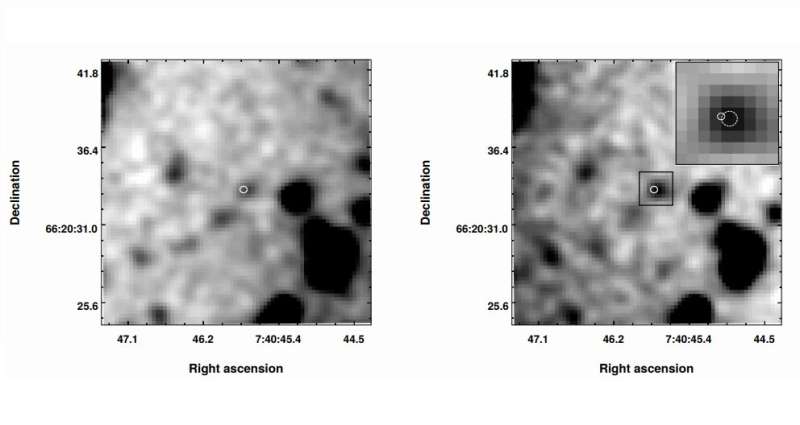March 7, 2019 report
Millisecond pulsar PSR J0740+6620 has a white dwarf companion with helium atmosphere, study suggests

A new study published February 28 on arXiv.org suggests that a millisecond pulsar known as PSR J0740+6620 has a stellar companion. The research provides evidence indicating that this object is most likely accompanied by an ultracool white dwarf exhibiting a pure helium atmosphere.
Pulsars are highly magnetized rotating neutron stars emitting a beam of electromagnetic radiation. The most rapidly rotating pulsars, with rotation periods below 30 milliseconds, are known as millisecond pulsars (MSPs).
Astronomers believe that MSPs are formed in binary systems when the initially more massive component turns into a neutron star that is then spun-up due to accretion of matter from the secondary star. Observations conducted so far seem to support this theory as more than a half of known MSPs have been found to have stellar companions.
Located some 1,300 light years away from the Earth, PSR J0740+6620 (or J0740 for short) is an MSP with a spin period of about 2.88 milliseconds. Previous studies of this pulsar suggested that it has a secondary star, most likely a white dwarf. Now, a new study published by Daria Beronya of Ioffe Physical-Technical Institute in Saint Petersburg, Russia, and colleagues provides more evidence supporting this assumption.
Using the Optical System for Imaging and low Resolution Integrated Spectroscopy (OSIRIS) of Gran Telescopio Canarias (GTC), Beronya's team performed deep optical observations of J0740 in December 2017 in order to identify a possible companion of this pulsar.
"We report detection of the likely companion of the binary millisecond pulsar J0740+6620 with the Gran Telescopio Canarias in the r′ and i′ bands. The position of the detected starlike source coincides with the pulsar coordinates within the 1σ uncertainty of ≈ 0.2 arcsec," the astronomers wrote in the study.
According to the paper, the companion has a minimum mass of about 0.2 solar masses, a temperature below 3,500 K and a cooling age of over five billion years. Furthermore, observational data indicates that the object has a pure helium atmosphere and is the reddest source among known white dwarf companions of MSPs.
Although the researchers suppose that the detected source is a white dwarf companion of J0740, other possibilities cannot be excluded yet. Alternative explanations taken into account are that the object is a red dwarf, red subdwarf or a brown dwarf. Moreover, the identified source could be not associated with J0740 at all, residing even outside our Milky Way galaxy.
Hence, in order to draw final conclusions about the nature of the discovered object, more observations are required.
"Deep infrared observations are necessary to clarify the properties and nature of the detected source. For a cool white dwarf with a pure helium atmosphere one can expect the blackbody-like spectral energy distribution. Future proper motion measurements can confirm the association of the likely counterpart with J0740," the astronomers noted.
More information: D. M. Beronya et al. The ultracool helium-atmosphere white dwarf companion of PSR J0740+6620? arXiv:1902.11150 [astro-ph.SR]. arxiv.org/abs/1902.11150
© 2019 Science X Network





















